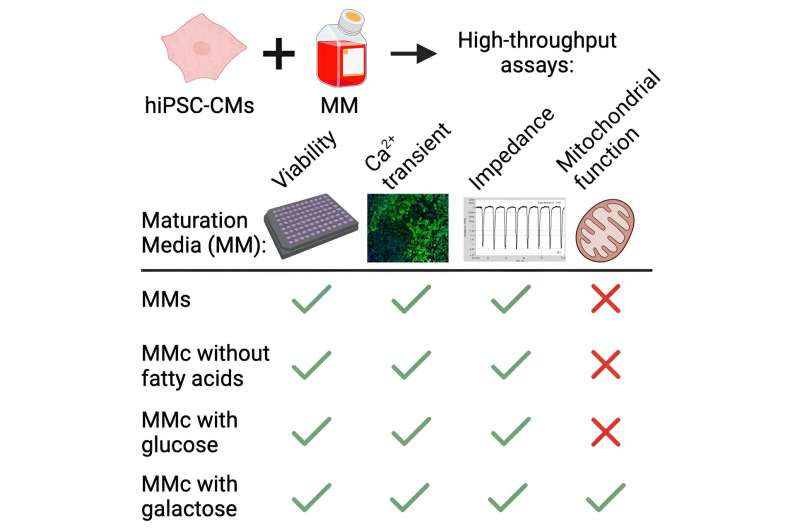This article has been reviewed according to Science X's editorial process and policies. Editors have highlighted the following attributes while ensuring the content's credibility:
fact-checked
peer-reviewed publication
trusted source
proofread
Improving models to study the human heart

Northwestern Medicine scientists have developed a new method to measure and optimize the maturation process of cultured heart muscle cells, an approach that has the potential to set the future standard for a common cell model in scientific research, according to details published in Cell Reports.
Human induced pluripotent stem cell-derived cardiomyocytes (hiPSC-CMs) are cultured heart muscle cell models widely used to study a variety of human heart disease and responses to experimental drugs. However, newly cultured cardiomyocytes don't accurately reflect mature heart muscle cells in adult humans, and previous methods of measuring maturation were not high throughput.
Differences in cellular maturity may affect the results of various experiments and studies done using the cells, so understanding when the cells are suitable is critical, said Paul Burridge, Ph.D., associate professor of Pharmacology and senior author of the study.
"The hiPSC-CM models don't perfectly match an adult cardiomyocyte," said Burridge, who is also a member of the Robert H. Lurie Comprehensive Cancer Center of Northwestern University.
"There are a number of ways you can make these cardiomyocytes more mature, but all of those techniques are time-consuming and not always compatible with the assays we perform, so we were really interested in what we could do to make these cardiomyocytes match an adult cardiomyocyte as much as possible."
In the study, Burridge and his collaborators cultured hiPSC-CMs and performed high-throughput assays to measure maturation of the cells. They found several factors could indicate when the cells are mature, including gene expression, mitochondrial function and electrical activity.
Building off this discovery, the investigators then developed cellular media—combinations of compounds and nutrients designed to support cultured cellular growth—and optimized it for the rapid maturation of the heart muscle cells.
The new measurement method and optimized cellular media will make it easier for scientists to study human heart cells, Burridge said.
"IPS cell-derived cardiomyocytes appear to be one of the most powerful applications of the IPS cell technology in drug screening," Burridge said. "The cells basically represent the heart cells of a patient. Whether we're interested in the effects of drugs, arrhythmia, or heart failure, we want to have the best models possible. Here, we have improved the fidelity of that model without making it more complex."
Moving forward, Burridge and his collaborators will continue to optimize the model to match human heart muscle cells as closely as possible, he said, and potentially reduce the need for animal models in scientific research.
"The better we can make this, the more work can be done in this cell culture model rather than in animal models such as mice, as it was done in the past," Burridge said. "By improving the quality of this model, that's going to get us a little bit closer."
More information: K. Ashley Fetterman et al, Independent compartmentalization of functional, metabolic, and transcriptional maturation of hiPSC-derived cardiomyocytes, Cell Reports (2024). DOI: 10.1016/j.celrep.2024.114160



















